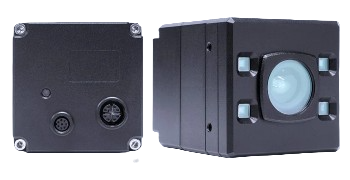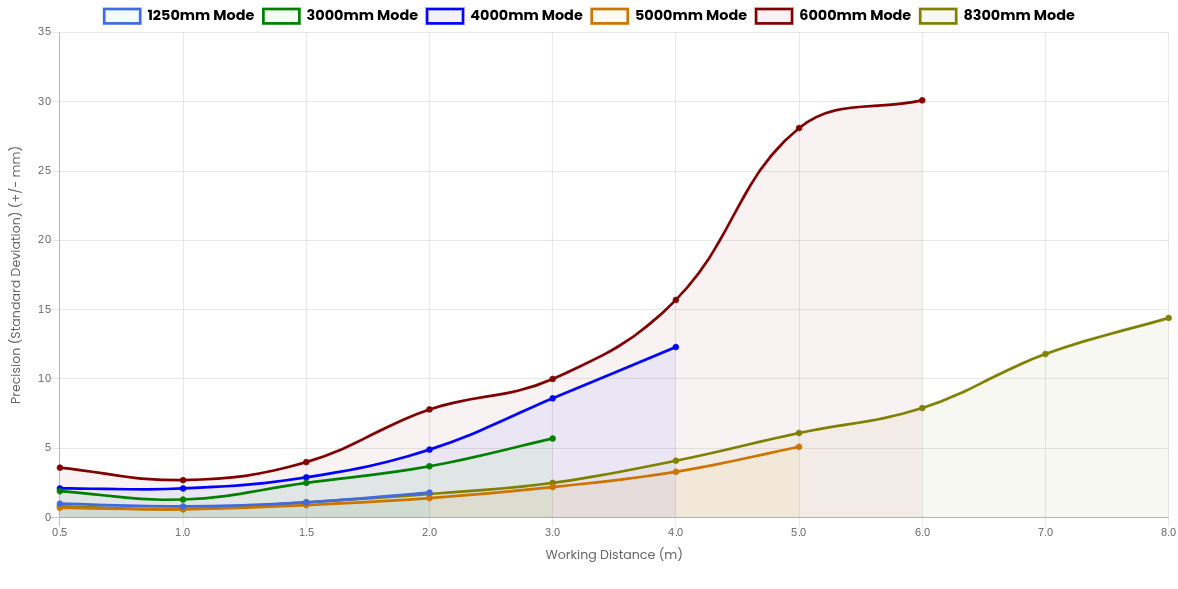
The Lucid Vision Labs Helios2+ Time of Flight (ToF) 3D camera features High Dynamic Range (HDR) mode, and High-Speed Time-of-Flight mode, and a Sony DepthSense™ IMX556PLR 1/2" global shutter CMOS back-illuminated ToF sensor.
The High Dynamic Range (HDR) mode combines multiple exposures to provide accurate 3D depth information for high contrast, complex objects containing both highly reflective and low reflectivity objects. High-Speed Time-of-Flight mode enables fast 3D image acquisition of moving objects with accuracy, and without distortion or blurring.
Helios2+ outputs 3D point clouds in real-time for use in a variety of industrial 3D sensing and depth measurement applications to sub-mm (< 1mm) precision, with optional 3.2MP color image texture-mapped overlay. Several operating distance modes (6 in normal mode, 3 in HDR mode, and 3 in High-Speed mode) maximize 3D performance based on the required distance range, and features the ability to adjust the starting point of each model along the entire working distance (0.3-8.3 meters in Normal and HDR modes, and 0.3-2.5 meters in High-Speed mode) of the camera.
Helios2+ 3D ToF cameras include the Arena SDK and 3D point cloud viewer software allowing for quick and easy integration into a wide range of 3D imaging applications.
All Lucid Vision Labs Helios2 3D ToF cameras, including the Helios2+ ToF camera, have an IP67 rating making them suitable for a wide range of indoor and outdoor applications. A GigE interface and plug-and-play functionality enables users to quickly integrate the camera into their systems and start capturing 3D data. Helios2 3D ToF cameras also include the Arena SDK and 3D point cloud viewer software.
Helios2 Family Datasheet Helios2 FoV & Model Comparisons

This video shows the High Dynamic Range (HDR) Mode in the Helios2+ 3D ToF camera. The HDR mode combines the best data from 3 manual exposure times: 62.5, 200, and 1000µs into 1 depth frame. HDR processing is performed on-camera without impacting the host PC's performance.
This video compares the normal 3D mode versus the high-speed modes on the Helios2+ 3D Time-of-Flight Camera. High-Speed modes can run at up to 110 fps, which is more than 3x faster than normal mode which runs at 30 fps. The illustrates how High-Speed mode captures fast moving objects without distortion and blurring.
This video shows High Dynamic Range (HDR) Mode in the Helios2+ 3D ToF camera with imaging a wheel/side of car. The HDR mode combines the best data from 3 manual exposure times: 62.5, 200, and 1000 µs into 1 depth frame. The video illustrates the camera's superb ability to capture images that have different materials and different reflective properties. The HDR mode processing is performed on-camera without impacting to the host PC's performance.

Exposure Time is 250μs for distances of 800mm and below, 1000μs for distance above 800mm.
| Distance (m) | Accuracy |
|---|---|
| 1250mm Mode (up to 1.25m) | ± 4 mm |
| 3000mm Mode (up to 3.0m) | ± 10 mm |
| 4000mm Mode (up to 4.0m) | ± 10 mm + 0.25% of depth |
| 5000mm Mode (up to 5.0m) | ± 4 mm + 0.1% of depth |
| 6000mm Mode (up to 6.0m) | ± 10 mm + 0.5% of depth |
| 8300mm Mode (up to 8.3m) | ± 4 mm +0.2% of depth |
| Distance (m) | 1250mm Mode | 3000mm Mode | 4000mm Mode | 5000mm Mode | 6000mm Mode | 8300mm Mode |
|---|---|---|---|---|---|---|
| 0.5* | 1.0 mm | 1.9 mm | 2.1 mm | 0.7 mm (0.629 mm) | 3.6 mm | 0.8 mm |
| 1 | 0.8 mm | 1.3 mm | 2.1 mm | 0.6 mm (0.287 mm) | 2.7 mm | 0.6 mm |
| 1.5 | 1.1 mm | 2.5 mm | 2.9 mm | 0.9 mm (0.463 mm) | 4.0 mm | 1.1 mm |
| 2 | 1.8 mm | 3.7 mm | 4.9 mm | 1.4 mm (0.726 mm) | 7.8 mm | 1.7 mm |
| 3 | 5.7 mm | 8.6 mm | 2.2 mm (1.296 mm) | 10.0 mm | 2.5 mm | |
| 4 | 12.3 mm | 3.3 mm (1.904 mm) | 15.7 mm | 4.1 mm | ||
| 5 | 5.1 mm (2.845 mm) | 28.1 mm | 6.1 mm | |||
| 6 | 30.1 mm | 7.9 mm | ||||
| 7 | 11.8 mm | |||||
| 8 | 14.48 mm |
The number in brackets () is Precision results of HDR Low Noise Mode. We are only showing the 5000mm mode results to illustrate the benefits but HDR mode is available for all distance modes and improves prevision for all modes.
*0.5 m distance precision measured with 250 µs exposure time, all other distances using 1000 µs exposure time measured with white paper target.
Test Conditions
Target: White paper mounted on bar attached to motion stage
Helios2+ positioning: mounted on tripod, laser distance meter used to measure distance from case front to stage zero position
Camera setting: Coord3D_C16 Pixel Format, bilateral filtering OFF, camera warmed up for 20 minutes.
Imaging environment: Room light on during testing, black material used to minimize reflections off floor
Motion stage moved in 50mm steps, for each step measure depth over 10x10 pixel ROI at image center, repeat 32 times at each position
Accuracy measured as difference between camera’s average measured depth across the ROI and 32 images and the ground truth depth (stage zero distance + stage position)